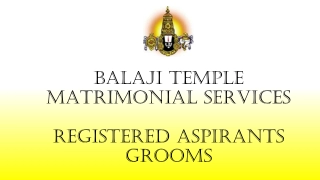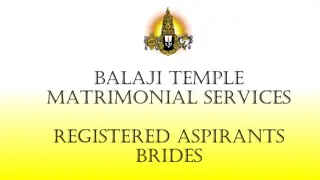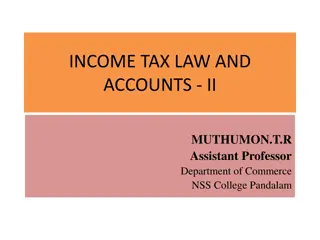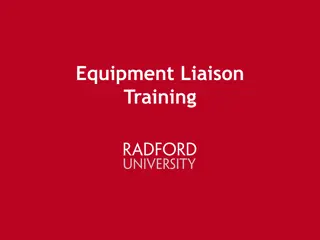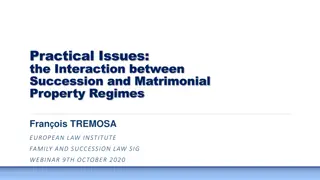Matrimonial Law Update: Treatment of Post-Separation Assets
Post-separation asset treatment in matrimonial law is examined post-Hart and Waggott case, analyzing the status of non-matrimonial property, trust claims, and the fairness of awards under the Matrimonial Causes Act.
Download Presentation

Please find below an Image/Link to download the presentation.
The content on the website is provided AS IS for your information and personal use only. It may not be sold, licensed, or shared on other websites without obtaining consent from the author.If you encounter any issues during the download, it is possible that the publisher has removed the file from their server.
You are allowed to download the files provided on this website for personal or commercial use, subject to the condition that they are used lawfully. All files are the property of their respective owners.
The content on the website is provided AS IS for your information and personal use only. It may not be sold, licensed, or shared on other websites without obtaining consent from the author.
E N D
Presentation Transcript
MATRIMONIAL LAW UPDATE MIRIAM FOSTER 29 BEDFORD ROW CHAMBERS
Matrimonial / Non Matrimonial Assets The prevailing approach post Hart and Waggott C v C [2018] EWHC 3186 (Fam) Principal issue between the parties was the treatment of H s earnings post separation and his accumulation of assets post separation. He sought to ring fence his post-separation assets and contended that he had made an unmatched contribution amounting to 8.27m W relied upon her contributions during the marriage and providing for the children post- separation. Robert s J s judgement analyses the status of the law post Hart and Waggott, stating: an earning capacity in terms of its present and future potential to generate income, the product of which may well be savings, investments or any tangible accretion of future capital wealth does not represent matrimonial property which is subject to the sharing principle. Similarly, she stated that W s ongoing support for the children was not an ongoing marital partnership. For that reason, Roberts J did not accept W s proposition that her ongoing contributions to the welfare of the family matched those of H s contributions and / or gave rise to any entitlement to an equal share in H s post-separation earnings.
Roberts J further stated that, following the Court of Appeals judgement in Hart, there were three stages to the court s approach to non-matrimonial property as follows: 1. The court must make factual determinations as to the presence of non-matrimonial property. It is open to the court to not make a finding that there is non-matrimonial property, in light of the contribution and its materiality / relevance. 2. In the event that there is not a clear dividing line between matrimonial and non-matrimonial property, the court must undertake a broad assessment of the extent of non-matrimonial property. 3. The court must undertake a holistic assessment of the fairness of an award, deploying all factors under s25 of the Matrimonial Causes Act 1973 ( MCA ), irrespective of whether or not there is a clear dividing line between matrimonial and non-matrimonial property.
Daga v Bangur [2018] EWFC 91 The court was concerned with H s claim against discretionary trusts established by the wife. The parties were married for 9 years They were young: 34 and 36 Both earned good salaries There was no matrimonial home as they had chosen to rent In the latter years of the marriage, W established two discretionary trusts into which her father invested 17.6m. H pursued a lump sum payment of 1.5m from the trusts to meet his needs. W s case was that H could meet his needs from his own income ( 130k net pa) Holman J, in addressing H s needs claim, noted that he could continue to enjoy a good lifestyle from his own income and emphasized that the parties had chosen to rent during the marriage. He further stated that, should H wish to buy a property, he could do so fairly soon without any capital provision from W.
IX v IY [2018] EWHC 3053 (Fam) Total net worth of c 38.3m Generated by H both pre-marriage and during the marriage through his business, working as a software engineer. W was a former model who no longer worked No children of the marriage (but both had children from previous relationships) The parties started cohabiting in 2007, married in 2013 and separated in 2017 W sought 50% of the assets on a sharing basis H proposed she should receive 13% on a needs basis, with H relying on his pre-acquired assets being ring-fenced With reference to Moylan LJ s judgement in Hart, Williams J noted: Happily, recent decisions of the Court of Appeal in the field appear to suggest a less technical, more flexible and more common-sense approach to such issues (dealing with non-matrimonial assets)
The balance of the authorities support an approach which permits the court in appropriate circumstances to identify an asset as a non- matrimonial asset, or part of an asset being identified as a non-martial asset, it seems to me that ultimately it is fact specific although the shorter the marriage, in practise, the easier it may be to identify a non- martial asset and the longer the period of the marriage and the greater to which the asset has a mingled character, the harder it may be to identify it.
In identifying and quantifying the extent of non-matrimonial assets, the husband argued that much of the current value of his company should be ring- fenced as being non-matrimonial because he carried out the heavy lifting building up the value of the business prior to the marriage. The husband also asserted that the growth in the value of the business during the marriage could be categorised as largely passive. On this issue, Williams J concluded: The weight of authority would support an approach which seems to identify and to take into account any latent potential that a business asset had when it was brought into the marriage by a party. The authorities would also support an allowance for passive growth of that latent potential during the course of the marriage. How that is to be done will depend upon the facts of the individual case.
Martin v Martin [2018] EWCA 2866 The Court of Appeal considered cross-appeals from an earlier decision of Mostyn J in which the bulk of the wealth was tied up in a company, which had been established by H prior to the relationship. The total assets were found by Mostyn J to be worth 182m, of which 80% was matrimonial property. Mostyn J awarded W one-half of the martial wealth, with an element of her award being made up of shares in the business.
Moylan LJ in the Court of Appeal held as follows: Assets have a different level of risk. As a matter of principle, the court must take this into account when applying the sharing principle. That extends to the quality of the assets, so that liquidity and illiquidity can equally be relevant factors in their own right. As to business valuations, there was no reason why the Court of Appeal should depart from the conclusions in Versteegh that valuations of private companies can be fragile and need to be treated with caution. Even where the Court can fix a value that does not mean that the value of the shares in a limited company has the same weight as the value of other assets. The court has to assess the weight, which can be placed on the value of an asset, even when using a fixed valuation. That applied to both the amount and the structure of the award so that the overall allocation between the parties by application of the sharing principle effects a fair balance of risk and illiquidity. The assessment of the weight that can be placed on a valuation is not a mathematical exercise but rather it is a broad evaluative exercise to be undertaken by the judge. As to the issue of non-matrimonial property, a judge has an obligation to ensure that the method selected leads to an award which they consider gives to the contribution made by one party s non-matrimonial property the weight he considers just with such generality or particularity as he considers appropriate in the circumstances of the case.
In applying those principles, the Court of Appeal took the following approach: Mostyn J was entitled to adopt a straight-line apportionment approach when determining which element of the current value of the company should be treated as non-matrimonial. His decision to apply that approach was not at variance with or contrary to the evidence. Accordingly, the wife s appeal against Mostyn s J s application of a straight-line approach was rejected. Mostyn J was held to be wrong when he said that the only difference between [the company] and cash proceeds is the sound of the auctioneer s hammer. That was viewed as a reference inapt to the circumstances of the case. There was a difference of substance between the value ascribed to the company and the other assets, including the cash to be extracted from the company by way of divided. Mostyn J had failed to consider whether his proposed award achieved a fair division of both the copper-bottomed assets and illiquid and risk laden assets.
The Court of Appeal returns to Versteegh in detail, including in relation to non-matrimonial property and Wells sharing. In relation to non-matrimonial property, King LJ notes that two schools of thought have developed in respect of their treatment: The arithmetical approach as per the Court of Appeal in Jones and which has been preferred by Mostyn J in his decisions; and The impressionistic approach which has generally been preferred by Moylan J in his decisions. King LJ concludes: where it becomes necessary to distinguish matrimonial property from non-matrimonial property the court may do so with a degree of particularity or generality appropriate in the case.
In coming to her conclusion, King LJ recognises the problems that arise in some cases in which it is impossible to value certain assets, as was the case in Robertson. She stated: In the majority of cases, the court will be able to value the assets, both matrimonial and non-matrimonial, and therefore, if appropriate, make orders by reference to a percentage of the total assets. That is not going to be the case in those less common cases such as the present one, where the court has been unable to place a value on certain of the assets.
There was a difficulty in the present case in valuing business assets. Counsel for W argued that as the judge had failed to value H s shares, the judge had failed to carry out the first stage of the two-stage process set out in Charman i.e. the computation stage which needs to take place before the distribution stage. In the present case, a total of 2m had been spent on experts. Despite that, the trial judge was unable even to make a conservative estimate as to the value of the husband s company. King LJ concluded: In my judgment, the judge cannot be criticised for concluding that he was unable to make findings as to the value of the development sites or as to future liquidity with a degree of reliability necessary in order to discharge the standard of proof. Further there can be no basis for suggesting that the failure by this highly experienced specialist judge to reach a valuation was his own fault.
The situation was similar to that in Wells in which it had been impossible to place any value upon the husband s shareholding. In the present case, W argued against a Wells sharing order, i.e. where businesses cannot be valued, the only right course of action is to transfer an interest in the business to W. W sought to argue that, effectively, Wells was a one off case. Although King LJ accepted that the making of a Wells order should be approached with caution, she did not accept that Wells was an unusual and singular case. Accordingly, a Wells sharing order was appropriate.
XW v XH [2019] EWFC 76 Baker J adopted the approach that had been taken by Moylan LJ in Hart and Roberts J in Vesteegh and Williams J in IX v IY. The judge disagreed with the approach that had been adopted in WM v HM by Mostyn J who adopted a straight line approach when looking at the growth and value of the business pre-marriage and during the marriage Baker J stated: As Arden LJ notes in Jones, the Court must try to look as far as it can at the reality of what actually happened rather than proceed on an artificial assumption of a straight-line growth from the date of foundation of the business up to the eventual sale.
Baker J also discussed the dichotomy between what he described as the formulaic approach and the broader approach, which was gaining favour post Hart. He stated: In this case I conclude that the evidence does not establish a clear dividing line between matrimonial and non-matrimonial property and it is neither proportionate nor feasible to seek to determine a clear line. Instead, I propose to undertake a broad evidential assessment before deciding how the wealth should eb divided. My assessment is that there was a significant, though quantifiable, latent potential in the company at the date of the marriage, which is not reflected in the formal valuation. The fact that there was such a latent potential in the company must, therefore, be taken into account when determining the extent to which there should be a departure from the sharing principle.
Income The five main lessons from cases over the past year are: 1. Basis of claim the meal ticket for life remains on the menu; but the ingredients are relevant! Evidence the level of appropriate income provision is a matter for the court not the parties and failure to give full disclosure can have continuing consequences even if later corrected Capitalisation calculation of a capitalised sum need not follow the Duxbury table; if you have the means, be wary of an application to vary leading to a capitalisation order Arrears there is no formal process to apply to enforce arrears older than 12 months and you remain in arrears even if an application to vary has been issued Costs failure to give full disclosure can displace the presumption of no order as to costs 2. 3. 4. 5.
Pre-nuptial Agreements The term nuptial agreements refers to both pre-nuptial and post-nuptial agremeents, i.e. those entered into before marriage ( pre nup ) and those entered into after marriage ( post nup ) Brack v Brack [2018] EWCA Civ 2862 The Court of Appeal was concerned with EU Maintenance Regulations in the context of PNAs. Involved a Swedish couple where H had been a McLaren racing driver. They had entered into 3 PNAs. The trial judge had held that the terms of the PNAs prevented the English court from making financial orders under the MCA and, in particular, maintenance prorogation clauses ruled out being able to make maintenance awards for the wife.
The Court of Appeal held that two of the PNAs were Swedish and unenforceable under Swedish law and the third agreement in the USA was not specific enough to have effect. It further held that where a PNA was unfair, a court was not restricted to just addressing needs but should consider compensation and sharing too. It did not matter that a reported case had not considered compensation / sharing (i.e. looked beyond needs) since Radmacher and the decision in Versteegh that a valid PNA could lead to unequal asset division did not preclude the court looking beyond needs Addressing just needs may well be the usual outcome to achieve fairness but, if necessary, a court could go beyond the amount required to satisfy needs. Under Radmacher, the court s discretion was wide to achieve fairness.
In KA v MA [2018] EWHC 499 (fam), W received more to meet her needs than provided for under the PNA, which was found to be unfair. Both parties were in their 50 s and had been married before. H had three sons from his first marriage and the couple had a son together. H was wealthy when they met. He had made it clear to W that he would only marry if a PNA was signed. Although W was reluctant and legally advised that she would be considerably worst off financially if she signed the PNA, she did so before the marriage. H did not seek to fully rely on the PNA and offered 1.6m by way of a clean break.
W conceded that she had understood the PNA but felt that the amount offered was far too low and unfair as it was well beneath her needs. The judge agreed and ordered 2.73m. This was still a level that was far below the family s lifestyle but recognised not only W s needs but also H s wealth prior to the couple meeting and the acknowledgement that W s claims were limited by the PNA. The PNA was valid but that was only one element for the court to consider. W needed a higher sum to satisfy the overarching criterion of fairness (as stressed by the court in Luckwell v Limata).
Trusts Where PNAs are a factor to take into account, other legal arrangements bind the court. Where a trust is involved, the court must ensure that the entitlement of a party is unequivocally established to exist. This was the subject of Wodehouse [2018] EWCA Civ 3009, where the Court of Appeal set out that: 1. There is no power under s23(1) MCA to make an order against a third party. 2. The husband was only a potential beneficiary of the trust. The trial judge had erred in assuming that the husband had a share but, in fact, he was guaranteed nothing from it.
In Daga (as above) one of the issues for the court was the availability of funds from a trust to satisfy a lump sum to a spouse. W was the settlor and a beneficiary of the trusts, which had been funded by W s father. Holman J heard evidence from W s father, who was resolute that even if a lump sum order were made against W, the father would advise the trustees that they should not distribute any funds to her with which to pay it. The letter of wishes was clear on the point and H was no longer a discretionary beneficiary of the trusts. Holman J held that it would not be possible to apply judicious encouragement to the trustees to provide the funds with which to pay the lump sum.
Holman J noted that: 1. The court must not put undue pressure on the trustees 2. It is not undue pressure if the interests of the other beneficiaries would not be appreciably damaged; and 3. The court must decide that it would be reasonable for the payer spouse to seek to persuade the trustees to release capital to enable that spouse to make proper financial provision for the payee s former spouse. The judge considered this was not the case here noting the wife had never received or sought any financial assistance from the trusts for her or the parties son.
Arbitration Awards Non-court dispute resolution, including arbitration, was set up and is administered by the Institute of Family Law Arbitrators (www.ifla.org.uk) Parties entering into arbitration do so by agreeing that the arbitration will be final and binding. They also agree, if necessary, to apply to the court after the arbitration award for a consent order confirming the terms. In BC v BG [2019] EWFC 7, W changed her mind once she saw the award and applied to the High Court to either reconsider the case or send it back to the arbitrator to do so.
Refuting the usual assumption that arbitration is only for the rich, the case involved parties with limited incomes and assets largely tied up in a home and pensions. It also reflected the unhappy experience of delay experienced by those using the family justice system. A three day hearing was fixed but cancelled by the court and the adjourned hearing months later was then cancelled too at the last minute as the judge was ill. Yet further months would be waited for another hearing so the parties decided to use arbitration instead, for a much speedier result. The court clarified the relationship between the arbitration award and the court order. The former was effective and binding between the parties without the latter. The purpose of the court order was to satisfy third parties such as pension providers, to dismiss claims and, if awarded, to give effect to a clean break.
BC v BG, S v S and DB v DLJ all establish that although the the court is not a rubber stamp for arbitration awards, it would be exceptional for the court to refuse to endorse an IFLA arbitration award. In BC v BG, the arbitration award was upheld and an order giving effect to its terms was made (and H awarded his costs). Although there have been over 250 arbitrations, it is striking that arbitrators remain relatively rare where it is often a more efficient means of resolving matters than through the courts, but retains the judges support.
Financial Remedies Court Pilot On 27 July 2018, Sir James Munby (President of the Family Division) issued a circular announcing an extension of the Financial Remedies Court Pilot Scheme and also encouraging the use of private FDRs. He stated that the expense of a private FDR can be greatly outweighed by the advantages gained. The very fact of investment by the parties will signify a voluntary seat at the negotiating table, rather than a sense of being dragged there. Furthermore, the private FDR judge will, by definition, have been given all the time needed to prepare fully for the hearing. Anecdotal evidence suggests that private FDRs have a very high settlement rate.
Enforcement Clearly, the most important objective for the client is to receive what the court orders. There has been some assistance provided in the reported decisions over the past 12 months. In Akhmedova [2018] EWFC 23 (Fam) an attempt by H to shield assets by arranging for them to be ostensibly owned by corporate entities, failed. Following the guidance in Petrodel, referring to the evasion principle the corporate veil was pierced . This is actually quite rare in practice but the court found that H had acted with impropriety and the order was necessary to achieve justice .
H was a Russian billionaire and had been ordered to pay a lump sum of 350m to W and to transfer certain property. The court was satisfied that he had then sought to hide his wealth amidst the labyrinth of his financial affairs. W took enforcement measures around the world, including in the Isle of Man and Dubai. The English court made an order to try and assist her in both jurisdictions. In order to do so, the court pierced the corporate veil of two corporate entities finding them to be mere ciphers of H. This enabled the court to order one of the companies to transfer to W a 260m yacht moored in Dubai.
Miriam Foster 29 Bedford Row mfoster@29br.co.uk 0207 404 1044


